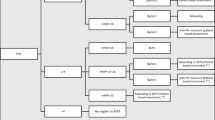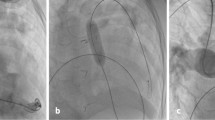Abstract
Objectives
The optimal tightness of bilateral pulmonary artery banding (BPAB) is considered to balance not only systemic-to-pulmonary blood flow but also each pulmonary blood flow, which is still challenging. To achieve them, we adopt the end-diastolic velocity (EDV) to the peak systolic velocity (PSV) ratio at BPAB with intraoperative epicardial echocardiography. We evaluated the usefulness of the EDV to PSV ratio and the patient outcomes.
Methods
34 patients underwent BPAB with this indicator and using a looped polytetrafluoroethylene suture. The PSV and the EDV to PSV ratio with echocardiography were measured in the intraoperative, early postoperative and late postoperative period. Lung perfusion scintigraphy was performed to quantify flow to each lung.
Results
There were 3 early deaths (< 30 days). Two patients required re-BPAB due to hypoxia. The intraoperative EDV to PSV ratios in the right and left were almost equal (0.50 ± 0.07 versus 0.51 ± 0.06, P = 0.73). There was no significant difference in the right and left EDV to PSV ratios throughout the postoperative course. The right PSV was smaller than the left PSV due to the Doppler angle intraoperatively (2.78 ± 0.57 versus 3.02 ± 0.50, P = 0.030). In addition, the PSV changed significantly until the late postoperative period (P < 0.001). Lung perfusion scintigraphy revealed only two patients had perfusion abnormalities.
Conclusions
Our clinical outcomes are satisfactory with low early mortality and a low rate of re-BPAB. The EDV to PSV ratio can be a reliable indicator to assess flow distribution to each lung and may be a valuable adjunct to achieve balanced systemic to pulmonary flow.






Similar content being viewed by others
References
Ota N, Murata M, Tosaka Y, et al. Is routine rapid-staged bilateral pulmonary artery banding before stage 1 Norwood a viable strategy? J Thorac Cardiovasc Surg. 2014;148(4):1519–25.
Sakurai T, Kado H, Nakano T, et al. Early results of bilateral pulmonary artery banding for hypoplastic left heart syndrome. Eur J Cardio-thoracic Surg. 2009;36(6):973–9.
Sakurai T, Sakurai H, Yamana K, et al. Expectations and limitations after bilateral pulmonary artery banding. Eur J Cardio-Thoracic Surg. 2016;50(4):626–31.
Haller C, Caldarone CA. The evolution of therapeutic strategies: niche apportionment for hybrid palliation. Ann Thorac Surg. 2018;106(6):1873–80.
Arlettaz R. Echocardiographic evaluation of patent ductus arteriosus in preterm infants. Front Pediatr. 2017;5:147.
Broadhouse KM, Price AN, Durighel G, et al. Assessment of PDA shunt and systemic blood flow in newborns using cardiac MRI. NMR Biomed. 2013;26(9):1135–41.
Yum SK, Moon C-J, Youn Y-A, Lee JY, Sung IK. Echocardiographic assessment of patent ductus arteriosus in very low birthweight infants over time: prospective observational study. J Matern Neonatal Med. 2018;31(2):164–72.
de Boode WP, Kluckow M, McNamara PJ, Gupta S. Role of neonatologist-performed echocardiography in the assessment and management of patent ductus arteriosus physiology in the newborn. Semin Fetal Neonatal Med. 2018;23(4):292–7.
Smith A, Maguire M, Livingstone V, Dempsey EM. Peak systolic to end diastolic flow velocity ratio is associated with ductal patency in infants below 32 weeks of gestation. Arch Dis Child - Fetal Neonatal Ed. 2015;100(2):F132–6.
Warnes CA, Williams RG, Bashore TM, et al. ACC/AHA 2008 American College of Cardiology/American Heart Association Task Force on practice guidelines (writing committee to develop guidelines on the management guidelines for the management of adults with congenital heart disease). Circulation. 2008;118(23):e714-833.
Davies RR, Radtke WA, Klenk D, Pizarro C. Bilateral pulmonary arterial banding results in an increased need for subsequent pulmonary artery interventions. J Thorac Cardiovasc Surg. 2014;147(2):706–12.
Ishii Y, Inamura N, Kayatani F, et al. Evaluation of bilateral pulmonary artery banding for initial palliation in single-ventricle neonates and infants: risk factors for mortality before the bidirectional Glenn procedure. Interact Cardiovasc Thorac Surg. 2014;19(5):807–11.
Sasikumar N, Hermuzi A, Fan C-PS, et al. Outcomes of Blalock-Taussig shunts in current era: a single center experience. Congenit Heart Dis. 2017;12(6):808–14.
Pizarro C, Murdison KA. Off pump palliation for hypoplastic left heart syndrome: surgical approach. Semin Thorac Cardiovasc Surg Pediatr Card Surg Annu. 2005;8(1):66–71.
Galantowicz M, Cheatham JP. Lessons learned from the development of a new hybrid strategy for the management of hypoplastic left heart syndrome. Pediatr Cardiol. 2005;26(2):190–9.
Fuchigami T, Nishioka M, Akashige T, et al. Growing potential of small aortic valve with aortic coarctation or interrupted aortic arch after bilateral pulmonary artery banding. Interact Cardiovasc Thorac Surg. 2016;23(5):688–93.
Taggart NW, Qureshi MY, et al. Patent ductus arteriosus and aortopulmonary window. In: Allen HD, Clark EB, Gutgesell HP, et al., editors. Moss and Adams’ Heart Disease in Infants, Children, and Adolescents. 9th ed. Philadelphia: Lippincott Williams and Wilkins; 2016. p. 803–20.
Kitahori K, Murakami A, Takaoka T, Takamoto S, Ono M. Precise evaluation of bilateral pulmonary artery banding for initial palliation in high-risk hypoplastic left heart syndrome. J Thorac Cardiovasc Surg. 2010;140(5):1084–91.
Musewe NN. Validation of Doppler-derived pulmonary arterial pressure in patients with ductus arteriosus under different hemodynamic states. Circulation. 1987;76(5):1081–91.
Author information
Authors and Affiliations
Corresponding author
Ethics declarations
Conflict of interest
Hiroshi Koshiyama declares that he has no conflict of interest. Takamasa Takeuchi declares that he has no conflict of interest. Junko Katagiri declares that she has no conflict of interest. Yusuke Iwata declares that he has no conflict of interest.
Additional information
Publisher's Note
Springer Nature remains neutral with regard to jurisdictional claims in published maps and institutional affiliations.
Rights and permissions
About this article
Cite this article
Koshiyama, H., Takeuchi, T., Katagiri, J. et al. A valuable echocardiographic indicator for the optimal tightness of bilateral pulmonary artery banding. Gen Thorac Cardiovasc Surg 70, 116–123 (2022). https://doi.org/10.1007/s11748-021-01674-6
Received:
Accepted:
Published:
Issue Date:
DOI: https://doi.org/10.1007/s11748-021-01674-6




